Yesterday I had the opportunity to visit the garden of Sue Fitz, a fellow plant collector here in Davis. The day started out mostly overcast, a rare thing for us in the summer, so I was able to take photos that hopefully do her garden justice.
I jokingly told Sue that her garden looked like an Annie’s Annuals catalog come to life. That’s actually not far from the truth: Many of her plants originally came from Annie’s, and her garden is eclectic and refuses to be put into a single category. Parts of it look like an English cottage garden, others resemble the kind of tropical plantings you might find in Florida or Hawaii. And in the back of her ¼ acre lot is a small Japanese garden complete with a torii gate and bamboo fence.
 |
| Panorama of Sue Fitz’s garden |
The first thing I noticed as I walked into Sue’s garden is a tree so bizarre that I found myself circling back to it on several occasions:
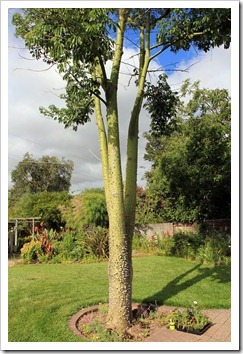  |
| Silk floss tree (Ceiba speciosa) |
This tree, variably called silk floss tree or drunken tree after its common name in Spanish, palo borracho, is native to the tropical and subtropical forests of South America. Its Latin name used to be Chorisia speciosa but it now goes by Ceiba speciosa, which puts it in the same genus as the famous Kapok tree.
The tree’s most outstanding feature are the triangular spines that cover the trunk. They start out a rich brown and eventually turn into a weathered gray. I just couldn’t get my eyes of these spiky protuberances!
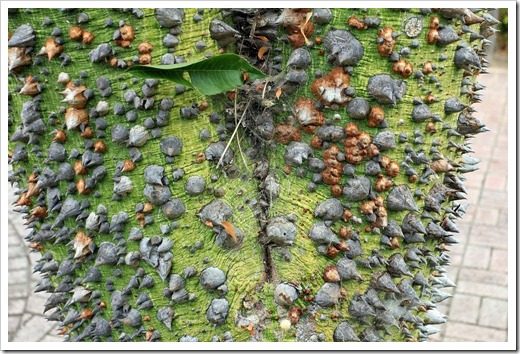 |
| Ceiba speciosa |
Sue bought the tree as a fairly small plant and didn’t expect it to survive our winters, as mild as they are. She protected it well during the first couple of years but after that it was left to its own devices. And it’s still here after all these years, impressing—or scaring—everybody who visits her garden.
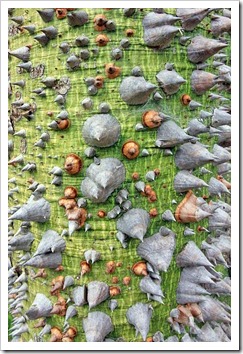  |
| Ceiba speciosa |
The next highlight of my visit was this tall stand of Mexican weeping bamboo (Otatea acuminata var. aztecorum). I’ve repeated professed my love for this unique bamboo and I was glad to see it do well in our climate.
 |
| Tropical bed with Mexican weeping bamboo (Otatea acuminata var. aztecorum) |
 |
| Sue next to her Mexican weeping bamboo |
The culms were a good 1½ inches in diameter and the one new shoot I noticed might be even thicker. Very nice indeed!
  |
| Mexican weeping bamboo (Otatea acuminata var. aztecorum) |
The tropical bed look lush and cool. I loved the many different colors and textures.
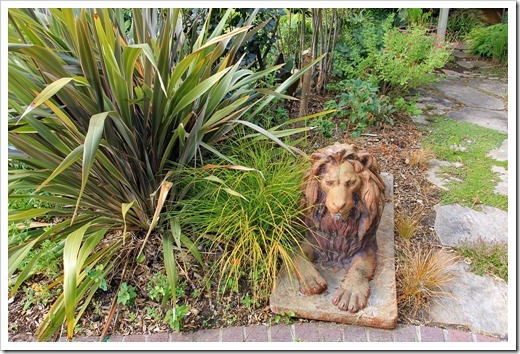 |
| New Zealand flax (Phormium tenax) next to a lion statue |
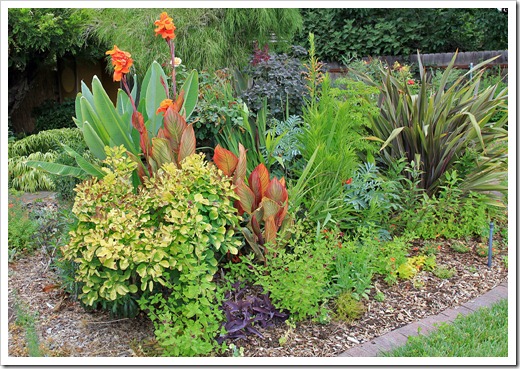 |
| Tropical bed |
Tucked away in the back of the tropical bed was another plant I’d never seen in person: Manihot grahamii. The foliage is gorgeous and in good conditions the plant can quickly grow to 8 feet. Since it self-seeds, Sue has several seedlings and she will pot one up for me.
 |
| Hardy tapioca (Manihot grahamii) |
 |
| Hardy tapioca (Manihot grahamii) |
One corner of the Japanese garden at the back of Sue’s property is anchored by an Alphonse Karr bamboo (Bambusa multiplex ‘Alphonse Karr’).
 |
| Bambusa multiplex ‘Alphonse Karr’ |
A contorted Atlas cedar (Cedrus atlantica) growing next to a torii gate sets a cool color accent.
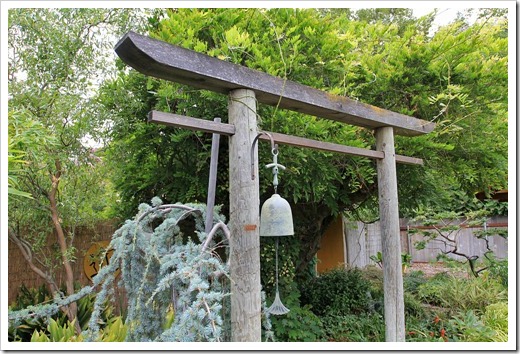 |
| Torii gate with Atlas cedar (Cedrus atlantica) |
The dominant feature in the Japanese garden is a wisteria that has completely swallowed up a dead cherry tree. The effect is stunning—it’s as if the wisteria itself were growing like a tree. I’d love to come back in the spring to see the wisteria in bloom!
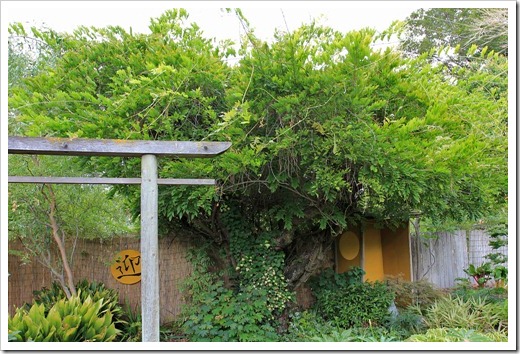 |
| Wisteria (Wisteria floribunda) taking over a dead cherry tree |
The front of the Japanese garden is bordered by a low bamboo fence partially hidden by picture perfect clumps of Japanese forest grass (Hakonechloa macra).
 |
| Variegated Japanese forest grass (Hakonechloa macra) |
 |
| Variegated Japanese forest grass (Hakonechloa macra) |
Another clump of Hakonechloa macra is found outside the Japanese garden where it is combined with smooth oxeye (Heliopsis helianthoides), a perennial aster that should be grown more often.
 |
Variegated Japanese forest grass (Hakonechloa macra) with
smooth oxeye (Heliopsis helianthoides) |
The Japanese garden itself is a study in foliage textures. While a vignette like the one in the next photo doesn’t attract the same attention as a tropical foliage bed, it follows the minimalist philosophy behind Japanese gardening.
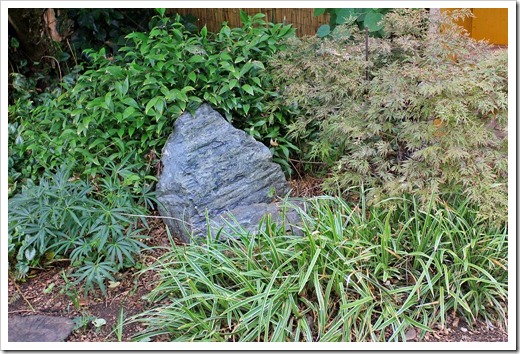 |
| Quiet corner in the Japanese garden |
The other end of the Japanese garden is anchored by a dwarf elm (Ulmus × hollandica ‘Jacqueline Hillier’) which Sue has shaped like a giant bonsai. I think it looks fantastic here.
 |
| Dwarf elm (Ulmus × hollandica ‘Jacqueline Hillier’) shaped like a giant bonsai |
An interesting sight just outside the Japanese gardening was rose campion (Lychnis coronaria) growing in the rotting stump of a palm tree. I thought Sue had planted them there but it turned out that they are volunteers.
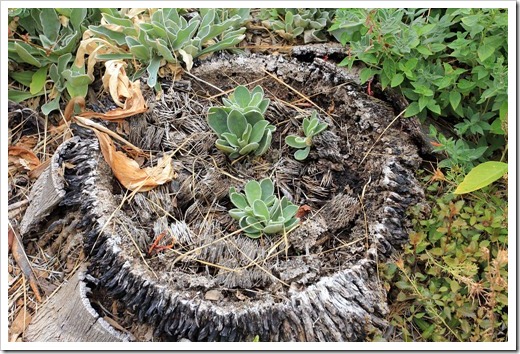 |
| Rose campion (Lychnis coronaria) growing in the rotten stump of a palm tree |
I was also intrigued by the stepping stones in the Japanese garden—buried rounds cut from a tree trunk—and near the vegetable garden—hand-made from concrete and decorated with leaf impressions. They add a great deal of texture to what would otherwise just be dirt.
  |
Lovely stepping stones
LEFT: tree trunk rounds
RIGHT: concrete with leaf impressions, handmade by Sue |
Sue’s expertise in combining colors and textures is evident in the many perennial beds. Any of them could have been featured in a gardening magazine.
 |
| Mixed perennial bed |
 |
| Mixed perennial bed |
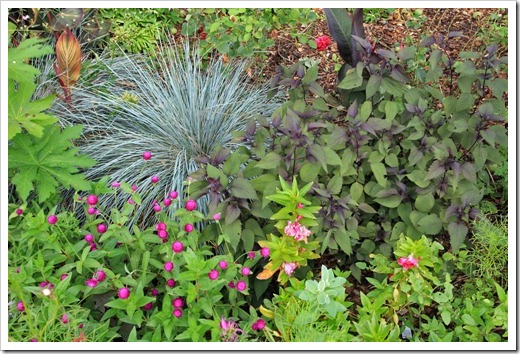 |
| Mixed perennial bed with Eupatorium rugosum ‘Chocolate’ |
 |
| Snow on the mountain (Euphorbia marginata) and Dahlia ‘Fascination’ |
I found snow on the mountain (Euphorbia marginata) to be a real standout. This annual is native to a wide swath of the U.S. from Minnesota to Texas. I must admit I’d never seen one before, but it is truly beautiful.
 |
| Snow on the mountain (Euphorbia marginata) |
Equally beautiful was this diminutive Dahlberg daisy (Thymophylla tenuiloba) growing in the cracks between two slabs of flagstone. It’s this attention to detail that makes a garden truly special.
 |
| Dahlberg daisy (Thymophylla tenuiloba) |
Another plant I really liked—and had never seen before—is red mallow (Pavonia missionum). Sue will pot up a seedling for me; it’ll look great combined with the grasses outside our front yard fence.
 |
| Red mallow (Pavonia missionum) |
I thoroughly enjoyed my visit to Sue’s garden and walked away with many inspirations.
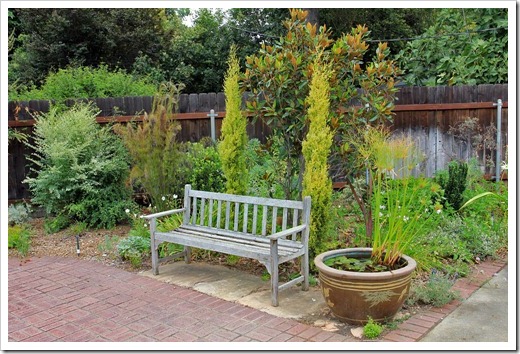 |
| Bench and papyrus |
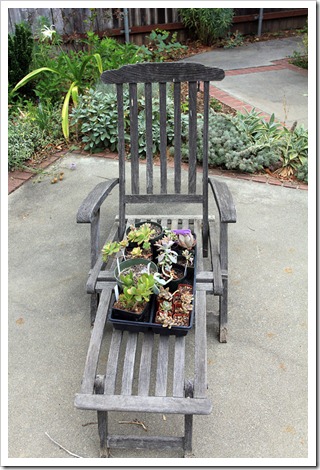 |
| Deck chair with some succulents I’d brought for Sue |
Sue works as a volunteer at a local high school where she is trying to build up a succulent and perennial collection for their greenhouse which was abandoned a few years ago due to a lack of funds. The goal is to sell plants in order to raise money for the department. I brought her some small succulent starts. If any of you have succulent cuttings you’d like to contribute to this good cause, please email me and I will put you in touch with Sue.



































Very nice! I wish I had the focus to keep "themed" beds like that. I'm more of a mix-all-the-plants-together gardener. :-)
ReplyDeleteSue would argue that she's the "mix-everything-together" kind of gardener as well but it somehow works like magic.
DeleteOh that Manihot...someday I'll have one! I passed up a perfectly lovely specimen a couple of years ago at Cistus what was I thinking!?
ReplyDeleteI can't wait to have a manihot myself. I will pamper it like a prized agave :-).
DeleteSue has got a lovely garden and like the way she has divided it into different sections with different themes. Love the Euphorbia marginata!
ReplyDeleteMe too! I'll try to get some Euphorbia marginata seed. I'm not into annuals (too much work) but will make an exception for this one.
DeleteSwell garden! I also adore the Manihot but have found it not reliably hardy in zone 8a (Darn!)
ReplyDeleteMaybe with enough protection? But invariably, the things we really want won't grow in our climate.
Delete